Tetra UNICORN Agent Installation Guide - Version 3.7.1
NOTETo restrict access to the local Tetra Agent Management Console, you can edit the Agent’s installation folder’s permissions to grant least privilege access. For more information, see Restrict Access to Agent Installation.
This guide is for the Tetra UNICORN Agent, version 3.7.1. It describes how to do the following:
- Install the Tetra UNICORN Agent
- Configure the Tetra UNICORN Agent and its services
- Monitor Agent Progress and Server System Metrics
NOTEIf you want to upgrade to a newer version of UNICORN, see Common Tetra Agent Upgrade and Installation Information.
Install the Tetra UNICORN Agent
To install the Tetra UNICORN Agent:
- Run the Windows Installation Package (msi file). You can select either:
- Upgrade to perform an upgrade and migrate the existing Agent database and configuration files from a previous version.
Upgrade OptionIf you select Upgrade, the Agent retains the configuration settings and database from the previous version. As a result, any files that were generated from UNICORN are not regenerated and uploaded to the Tetra Data Platform (TDP).
- New Installation to install a new Agent and replace the existing Agent database and configuration files.
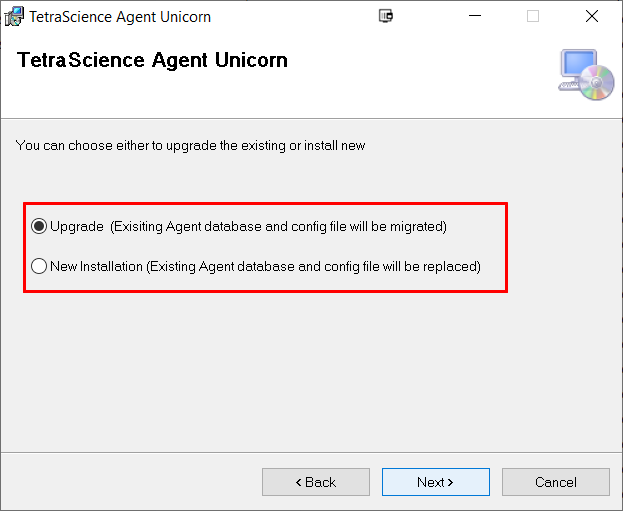
Tetra Agent UNICORN Installation options
- After the UNICORN Agent has successfully installed, click the Tetra Agent UNICORN shortcut from the Windows Program Menu to open the Windows-based Management Console.
- From the Management Console, you can configure the Tetra UNICORN Agent settings and review the Agent progress.
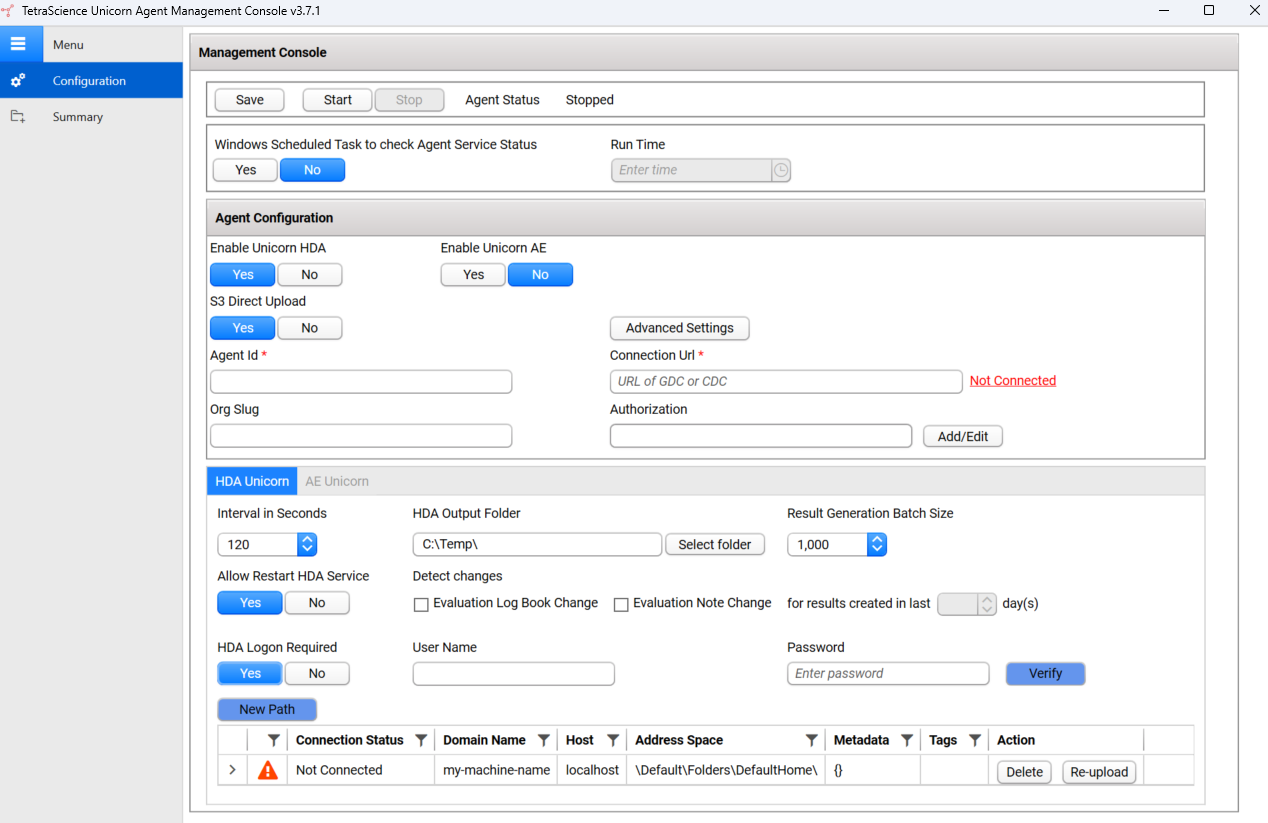
Tetra UNICORN Agent Management Console
Configure the Tetra UNICORN Agent and its Services
You can use the Management Console to:
- Start and stop the Agent
- Set a Windows Scheduled task
- Configure the UNICORN Agent
- Configure the UNICORN Agent services
- Set up the data connection to the TDP
Section 1: Start and Stop the Agent
This section indicates the Agent's processing using these statuses:
- Agent Service Not Installed
- Running
- Stopped

Agent Processing Status
- To save the UNICORN Agent configuration changes, click Save.
- To start the UNICORN Agent with the new configuration settings, click Start. When the UNICORN Agent starts, the status indicator shows Running for an Agent that is successfully up and running.
- When the UNICORN Agent starts, the Stop button is enabled. To stop the UNICORN Agent, click Stop.
Section 2: Set Windows Scheduled Task
You can increase the Agent's reliability by ensuring that it remains online without having to manually check it each day.
- Select Yes to enable the Windows Scheduled Task to check Agent Service Status option on a daily basis.
- Specify the time in the Run Time field when you want the scheduled Windows task to check on the status of the UNICORN Agent service. The Windows Task that you created runs under the LocalSystem account.
- If the Agent is stopped, then the scheduled Windows task automatically restarts the Agent service.
- If the Agent is running, nothing further happens.
- If you manually stop the UNICORN Agent, then the Windows task is removed.
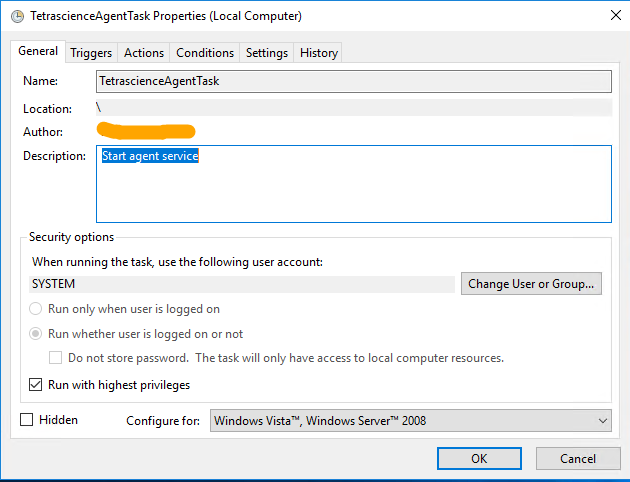
Windows Scheduled Task
Section 3: Configure the UNICORN Agent
UNICORN Agent Services
The Tetra UNICORN Agent provides two services:
- HDA Service: Detects the UNICORN result files through OPC Historical Data Access.
- Alarms and Events (AE) Service: Detects the alarm and events raised from the UNICORN Instrument service.
Select Yes to enable one service, or both of these services.
IMPORTANTThe Alarms and Events (AE) Service is in beta release currently and may require changes in future Tetra UNICORN Agent releases. For more information, or to activate this feature in your TDP environment, contact your customer success manager (CSM).
Advanced Settings
- Click Advanced Settings to open the Agent Configuration Advanced Settings pane.
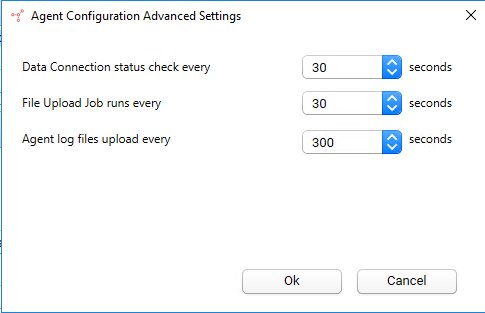
Agent Configuration Advanced Settings
You can specify the time intervals for these fields (default value for each field is 30 seconds):
- Data Connection status check every - Indicates how often the software checks the status of the connection (heartbeat) between the Tetra Data Platform and the UNICORN Agent. If TDP does not receive a message indicating that the UNICORN Agent is "alive" for more than 5 minutes, it assumes that the Agent is offline.
- File Upload Job runs every - Indicates how often to upload files to the Tetra Data Lake.
- Agent log files upload every - Indicates how often to upload log files to the Tetra Data Lake.
Software Version 3.4 UpdateTo improve readability, the After a watched file is modified, wait for it to stop changing field was renamed to File Upload Job runs every, and the Upload Log File field was renamed to Agent log files uploads every.
S3 Direct Upload
To have the Tetra UNICORN Agent directly upload files to Amazon Simple Storage Service (Amazon S3) buckets in the Tetra Scientific Data and AI Cloud by using AWS API endpoints, set the S3 Direct Upload option to Yes. When you set this option to Yes, you can upload a maximum file size of 5 TB. No is the default setting. For more information, see S3 Direct Upload (Recommended).
SQLite Database File BackupsTo enable the Tetra UNICORN Agent to automatically perform regular backups of the SQLite database file, set the S3 Direct Upload option to Yes. When you enable this option, the SQLite database file (which stores agent configuration data) is uploaded to the backup bucket in the Tetra Data Lake. If a Tetra UNICORN Agent failure occurs, you can restore the database file from the backup bucket and continue processing.
If you do not use not use the S3 Direct Upload option, then we recommend that you create periodic backups of the Tetra Agent database, which is typically stored in the installation folder under
C:\\TetraScience\<agent>\\Bin\\Database. In the event of a failure (for example, if the host server drive is lost), this would enable the data extraction to continue from where it left off without having to re-upload all of the data.
Agent ID and Connection URL
Before you set up a Tetra UNICORN Agent, you must enter:
- (Required) An Agent ID. The Agent ID (a UUID) is used to connect the Tetra Data Platform. You can retrieve Agent ID from the Tetra Data Platform when you set up the Agent.
- A full connection URL for the TDP connection endpoint that you're using:
- Generic Data Connector (GDC):
http://10.100.1.1:8888/generic-connector/v1/agent - Hub:
http://10.100.1.2:8443/generic-connector/v1/agent - TDP:
https://api.tetrascience-dev.com/v1/data-acquisition/agent/
- Generic Data Connector (GDC):
Verify the Agent ID and Connection URL
- Agent ID is required.
- The connection URL is required only if you're uploading RAW files to the TDP.
- Before you use your Agent ID and connection URL, it’s strongly recommended that you verify both with your TetraScience Customer Success Team.
If you do not use a connector, then you must do the following:
- When using the JWT token, the Org Slug field is required. Enter the Org Slug to attach it to the header.
- Enter the JWT token in the Authorization field to attach it to the header. To learn how to get the JWT token, see this reference.
- Click Add/Edit to open a dialog and enter the JWT token.
- Click Save to close the dialog and encrypt and save the JWT token. The Agent validates the connection immediately and displays the updated connection status next to the Connection URL field.
Section 4: Configure UNICORN Services
Configure HDA Service
The Tetra UNICORN Agent HDA Service is used to detect the UNICORN result files through OPC Historical Data Access.
To activate and configure the HDA Service, do the following:
- When you select Yes for the Enable Unicorn HDA field, the HDA Unicorn information displays at the bottom of the Management Console pane.
- Set the Interval in Seconds field to indicate how often the Tetra Agent scans UNICORN to detect the new result files.
- Select the HDA Output Folder to where you want to temporarily store the generated RAW files before uploading. You can use the default (C:\Temp) location, or provide a different folder. If the folder does not exist, then the Agent creates the folder.
- The Result Generation Batch Size specifies how many result files will be batched together for generation. The default value is 1000. For each batch there will be one HDA connection to UNICORN. To learn more about how this and other settings can be used to tweak latency and number of HDA connections, see here.
- Select Yes to Allow Restart HDA Services to allow the Agent to restart the HDA service, if required. For details, click here.
- Set Detect changes for Result files using:
- Evaluation Log Book Change
- Evaluation Note Change
- Results created in the last x number of days.
You can learn more about the results created in the last x number of days here.
- If you want to control the access to UNICORN using a specific UNICORN account, you need to turn on the HDA logon required option from UNICORN and, in the UNICORN Agent, select Yes for HDA Logon Required. You'll also need to add a username and password. For more information on this security feature, see the HDA Logon Required section later in this topic.
- The table specifies the UNICORN path containing: Domain Name, Host, and the Address Space of the Result File folder. If required, a UNICORN Agent can monitor multiple addresses spaces. To create a new path, click New Path, or double-click the existing path in the table open the Unicorn Path Editor window.

UNICORN Path Editor

Unicorn HDA Service configuration
To define a valid path, you must enter:
- Domain Name - Must be a unique name that identifies the UNICORN Host. It is used as part of File Path when the file is uploaded to TDP.
- Host - Local server name or IP address. It is part of the connection string used to access UNICORN OPC HDA service.
- ProgId - Static value UNICORN_HDAServer12.1 is used to identify UNICORN OPC HDA service. It is used by the OPC protocol. (Currently, this value, cannot be changed. This value is valid for UNICORN 6.x and 7.x.)
- Address Space - UNICORN HDA folder path. To learn how to find the address, click here. The folder name is case-sensitive.
- Metadata - A key/value pair that specifies the metadata associated with the output files uploaded to TDP. You can add or edit metadata as needed.
- Tags - Specifies tags associated with the files uploaded to TDP. Tags are comma-delimited strings that are associated with output files uploaded to TDP.
Metadata and TagsTo learn more about metadata and tags, including which characters you can use, see this topic. There's also more information about Metadata and Tags near the end of this topic.
Regeneration options (by detecting changes) enable you to automatically upload new versions of data when the Evaluation Log Book or Evaluation Notes change.
For more control over data management, you can enable or disable the rules for the Tetra UNICORN Agent to determine file change:
- Evaluation Log Book Change
- Evaluation Note Change
Click the check box next to the Evaluation change (s) you want to include. If these changes are excluded, then no automatic reuploads are generated when an evaluation log book or evaluation note changes.
Experimental FeatureThe Detect changes feature is an experimental feature because the integration with UNICORN does not provide a native API to detect Evaluation Notes or Evaluation Log Book changes. The Agent infers those changes by parsing the UNICORN logs (and in some cases, it is not accurate), resulting in unnecessary re-uploads. Use this feature if you need the latest version of the Evaluation Log Book or Evaluation Notes, but be aware that you will have multiple versions of the same file, and that new version of data may re-trigger pipelines.
To re-upload the result files:
- Click Re-upload from the Action column in the address path.
- Set the Reupload Start Date and Reupload End Date. The Tetra Agent will upload any files that were created or updated where the "Result Creation Date" is within this date timeframe. The "Result Creation Date" in UNICORN is the original testing date or the date when the result file was imported into a UNICORN system from another UNICORN system.
- Click OK.

Re-upload result files within specified date range
The Agent verifies the folder path and the user permission when iterating the folder paths. It reuploads the result files using the Result Creation Date within the selected time range.
The Agent also displays an icon in front of every folder path to indicate whether the folder path is valid; a green checkmark for valid, or an orange warning triangle for invalid. The Agent keeps checking the folder paths at each interval, and updates the status if there are any changes.
Configure the AE Service
IMPORTANTThe Alarms and Events (AE) Service is in beta release currently and may require changes in future Tetra UNICORN Agent releases. For more information, or to activate this feature in your TDP environment, contact your customer success manager (CSM).
The AE service detects the Alarm and Events generated from the UNICORN Instrument service.
To enable and configure the AE Service, do the following:
- When you select Yes for the Enable Unicorn AE field, the AE Unicorn information displays at the bottom of the Management Console pane:

UNICORN AE Service configuration
Similar to the HDA Service, the Agent can detect the Alarms and Events from multiple paths. When necessary, you can delete an existing path.
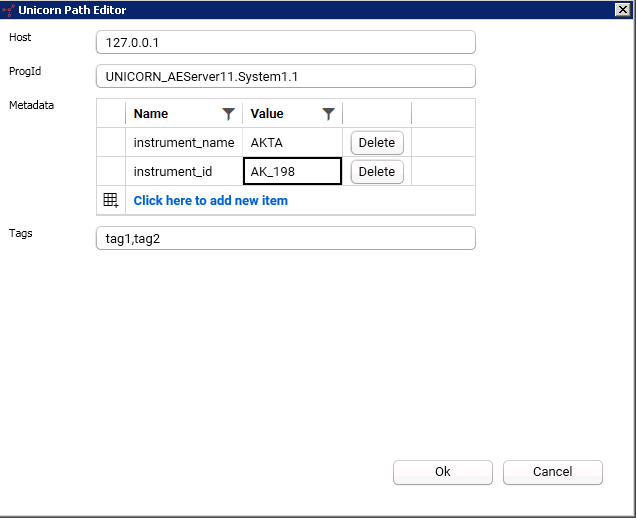
AE Path Editor
- To define a valid path, you must enter:
- Host - Local server name or IP address hosting the UNICORN Agent. We recommend that you use a real machine name or IP address as the host.
- ProgId - Static value UNICORN_AEServer11.System1.1 is used by OPC to identify the UNICORN AE service.
- Metadata - A key/value pair that specifies the metadata associated with the files uploaded to TDP. You can add or edit metadata as needed.
- Tags - Specifies tags associated with the files uploaded to TDP.
- Click Save to save the configuration and start the Agent.
Daily Agent Run ScheduleAfter you complete the initial installation and configuration, you can use a Windows Task script to re-start the Tetra UNICORN Agent (for example, you can set it to run at 1:00 AM) and ensure that it runs constantly. For details, see link.
The Tetra UNICORN Agent does two account verifications automatically in the following two scenarios.
- When the Windows Configuration UI launches first time.
- When the user click the Start button to start the service.
To avoid unexpected behavior from OPC, please create a dedicated user account to restrict the OPC access from Tetra UNICORN Agent.
Passing User Credentials (HDA Logon Required)
Dedicated User AccountWe recommend you use a dedicated user account instead of using a normal user account with Evaluation Logbook change turned on to detect the Result File change.
You can pass user credentials via the Tetra UNICORN Agent when extracting UNICORN Result files through the UNICORN OPC HDA Service. Using this feature allows the Tetra UNICORN Agent to only access the user has permissions for.
To configure this please contact your CSM for the detailed steps.
Potential Issues and Limitations
Data Integrity Risks
Since you can switch to a different user, it can lead to potential data duplication.
This approach could cause the Tetra UNICORN Agent to extract and generate the Result files from UNICORN again. Because the user account name is part of the Result File OPC Address space, Result files can have a different OPC address even though both OPC addresses point to the same result file in the UNICORN database.

For example, when the user switches the user account from “Administrator” to “UNICORN_Test”, it can lead to the following:
- The files in the folder of Administrator\Folders\Defaulthome are not accessible anymore.
- The files under the folder of Administrator\Folders\Test will be regenerated, because the files have different OPC address space after the account is switched. For example,
- When logging in as Administrator, the Result file, Test\UNICORN_Test2\EXPORT TEST 2 , has OPC address Administrator\Folders\Test\UNICORN_Test2\EXPORT TEST 2.
- When the UNICORN_Test user logs in, its OPC Address becomes UNICORN_Test\Folders\Test\UNICORN_Test\EXPORT TEST 2.
NOTEThis could cause the same result to be uploaded multiple times. In the example above, EXPORT TEST 2 would be uploaded twice. You should be fully aware of this risk before you start to use this feature.

Method Run Issues
To determine if the Method run completes, the Agent checks the pattern using a regular expression. A date time stamp needs to be evaluated. however, the date-time format is based on the hosting machine. Currently, the supported Date time format is MM/dd/yyyy. When the Agent is deployed to new clients, it is better to check the Date time format in the host machine. The Agent might need to include an additional date time format.
There have been situations that the Method run finishes with errors. The event log looks like this: An error occurred that caused the run to end and the result to be saved. Error description: Instrument network connection lost during run (System). If it happens that the Result file is not generated by the UNICORN Agent, a potential solution for the end-user is to open the Result file from UNICORN Evaluation Module, which will add a new entry to Evaluation Log. With that, the Agent can generate the Raw file
Monitor Agent Progress and Server System Metrics
To review the UNICORN Agent's run time progress and host server's system metrics, select Summary to open the Summary dashboard:
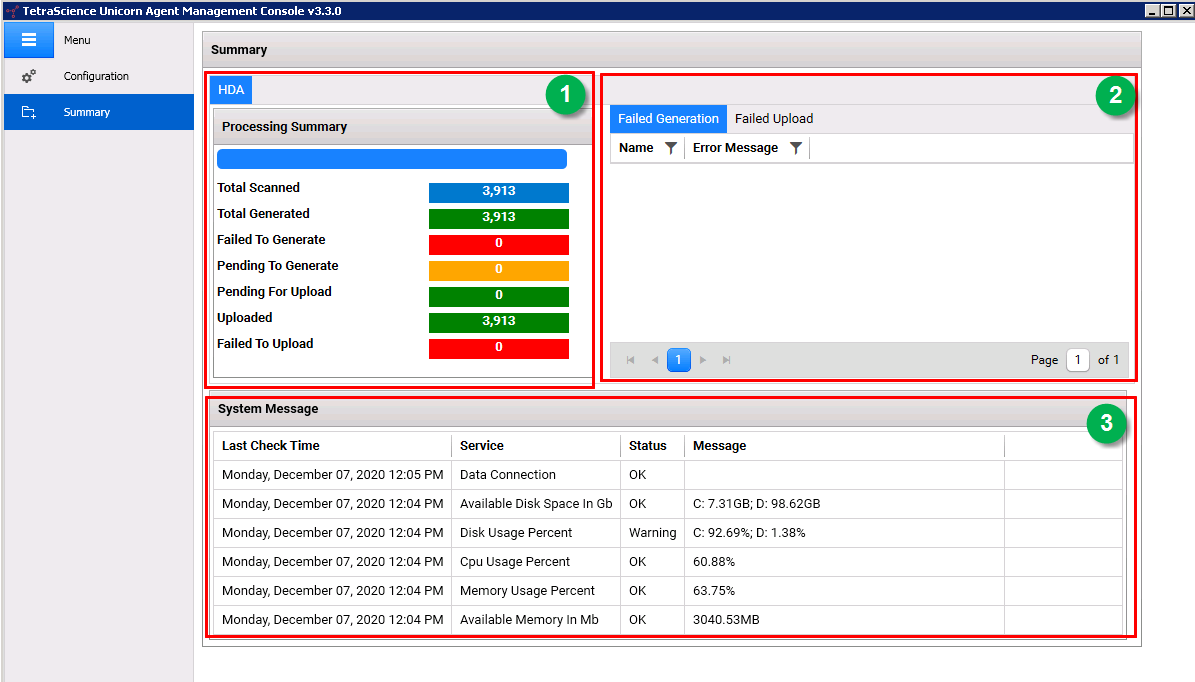
Summary Dashboard
Section 1: HDA Processing Summary
This section displays the HDA Service status where you can review how many UNICORN HDA result files were detected, generated, and uploaded. If any failure occurs, the numbers display here.
Section 2: Error Messages
This section displays any detailed error messages that occurred during the result file generation and file upload. It displays the file name and error messages.
Section 3: Host Server System Metrics
This section displays the host server system metrics and messages every minute and provides these metrics:
- Data Connection (connection status between the Agent and TDP.)
- Available Disk Space (in GB)
- Disk Usage (as a % of the total)
- CPU Usage (as a % of the total)
- Memory Usage (in MB)
Updated 2 months ago
